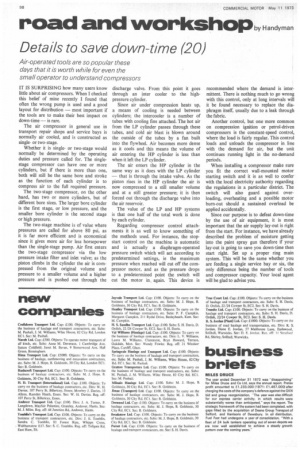Details to save down-time (20)
Page 100

If you've noticed an error in this article please click here to report it so we can fix it.
Air-operated tools are so popular these days that it is worth while for even the small operator to understand compressors
IT IS SURPRISING how many users know little about air compressors. When I checked this belief of mine recently I found that often the wrong pump is used and a good layout for distribution — most important if the tools are to make their best impact on down-time — is rare.
The air compressor in general use in transport repair shops and service bays is normally air cooled, and is constructed as singleor two-stage.
Whether it is singleor two-stage would normally be determined by the operating duties and pressure called for. The singlestage compressor can have one or more cylinders, but if there is more than one, both will still be the same bore and stroke as the function of each cylinder is to compress air to the full required pressure.
The two-stage compressor, on the other hand, has two or more cylinders, but of different bore sizes. The larger bore cylinder is the first stage, or low pressure, and the smaller bore cylinder is the second stage or high pressure.
The two-stage machine is of value where pressures are called for above 80 psi, as it is far more efficient and is economical since it gives more air for less horsepower than the single-stage pump. Air first enters the two-stage compressor via the low pressure intake filter and inlet valve; as the piston climbs in the cylinder the air is compressed from the original volume and pressure to a smaller volume and a higher pressure and is pushed out through the
discharge valve. From this point it goes through an inter cooler to the highpressure cylinder.
Since air under compression heats up, a means of cooling is needed between cylinders; the intercooler is a number of tubes with cooling fins attached. The hot air from the LP cylinder passes through these tubes, and cold air blast is blown around the outside of the tubes by a fan built into the flywheel. Air becomes more dense as it cools and this means the volume of air entering the HP cylinder is less than when it left the LP cylinder.
The air enters the HP cylinder in the same way as it does with the LP cylinder — that is through the intake valve. As the piston rises in the HP cylinder the air is now compressed to a still smaller volume and at a still greater pressure; it is then forced out through the discharge valve into the air reservoir.
The value of the LP and HP systems is that one half of the total work is done by each cylinder.
Regarding compressor control attachments it is as well to know something of the methods used. For instance, the stopstart control on the machine is automatic and is actually a diaphragm-operated pressure switch which will act according to predetermined settings, ie the maximum pressure when reached will cut off the compressor motor, and as the pressure drops to a predetermined point the switch will cut the motor in. again. This device is
recommended where the demand is intermittent. There is nothing much to go wrong with this control, only at long intervals will it be found necessary to replace the diaphragm itself, usually due to a leak through the fabric.
Another control, but one more common on compression ignition or petrol-driven compressors is the constant-speed control, where the load is fairly regular. This control loads and unloads the compressor in line with the demand for air, but the unit continues running light in the no-demand periods.
When installing a compressor make sure you fit the correct wall-mounted motor starting switch and it is as well to confer with the local electricity authority regarding the regulations in a particular district. The switch will also guard against overloading, overheating and a possible motor burn-out should a sustained overload be applied accidentally.
Since our purpose is to defeat down-time by the use of air equipment, it is most important that the air supply lay-out is right from the start. For instance, we have already described the problem of moisture getting into the paint spray gun therefore if your lay-out is going to save you down-time then start right. Set up a proper ring main system. This will be the same whether you are feeding a single service bay or six, the only difference being the number of tools and compressor capacity. Your local agent will be glad to advise you.



























































































































































































































